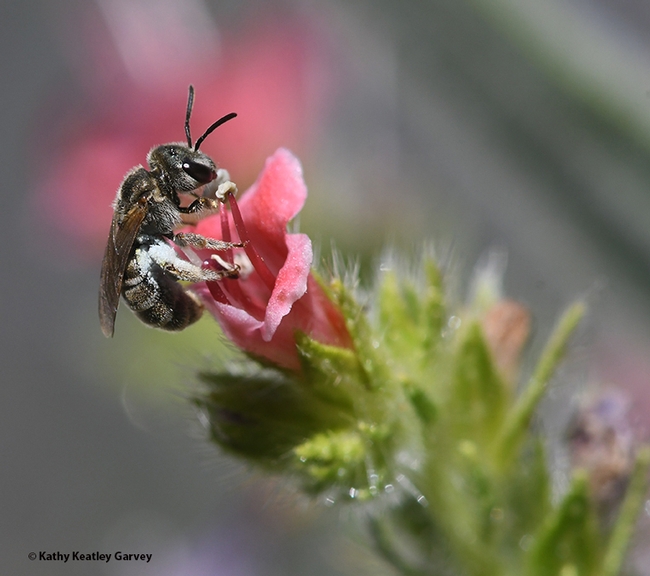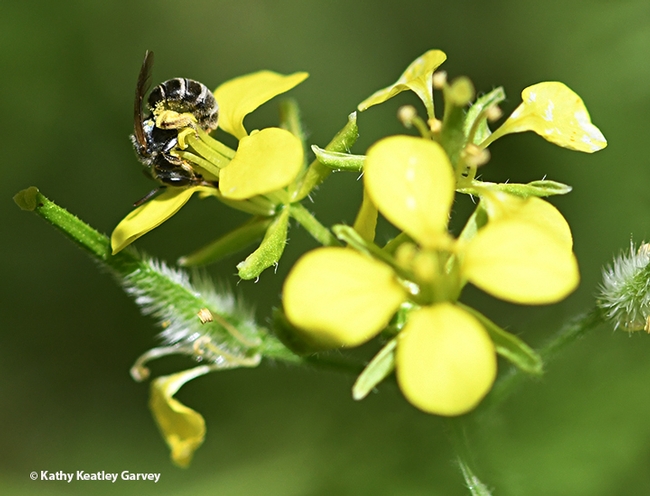- Author: Kathy Keatley Garvey
It's National Pollinator Month, and what better time to find a tiny speck of a bee on a seven-foot tower of jewels, Echium wildpretii?
This is a sweat bee of the family Halictidae, the second largest family of bees, comprised of some 4500 species. The family is found on every continent except Antarctica.
Sweat bees--as the name suggests--are attracted to perspiration. The oldest fossil record dates back to the Early Eocene epoch, which lasted from about 56 to 33.9 million years ago.
A tiny speck of a bee finding a tiny bit of pollen, much as it did millions of years ago...
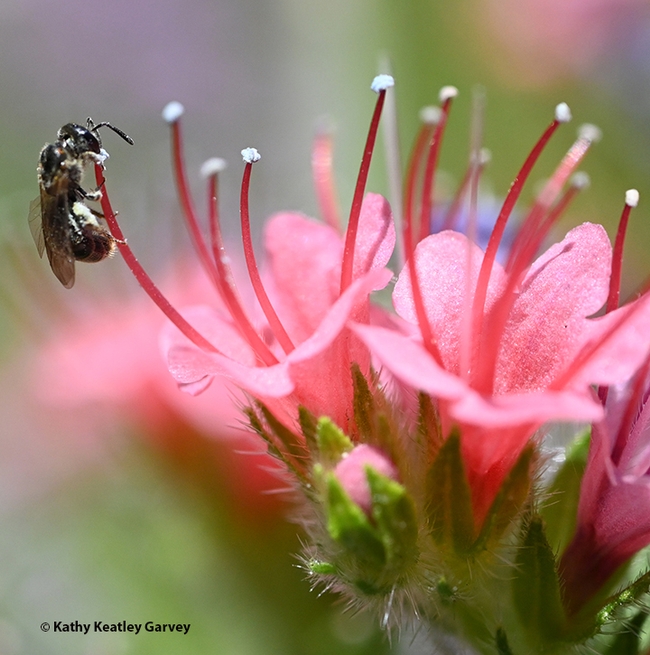
- Author: Kathy Keatley Garvey
In the sweltering heat of Solano County (100 degrees) during National Pollinator Month, how about an image of a sweat bee, genus Halictus, a tiny bee that's often overlooked in the world of pollinators.
It's a social bee that nests in the soil. "These nests consist of a complex of tunnels with individual brood chambers," according to California Bees and Blooms: A Guide for Gardeners and Naturalists (Heyday), the work of UC-affiliated scientists,
My camera caught this Halictus flying over Coreopsis in our Vacaville pollinator garden on June 5.
Camera: Nikon Z8 with a 50mm lens
Settings: Shutter speed, 1/4000 of a second; f-stop, 5; ISO 500.
UC Davis distinguished professor emerita Lynn Kimsey, emeritus director of the Bohart Museum of Entomology, and Bohart Museum scientist Sandy Shanks said the species appears to be Halictus ligatus.
Most Halictus species are generalist foragers, according to the Great Sunflower Project. "They use all sorts of genera of plants from the Asteraceae to Scrophulariaceae. They are very common on composites (daisy-like disc and ray flowers) in summer and fall."
We've seen them on everything from mustard to milkweeds to catmint to rock purslane, from spring to fall. They also appear regularly on the tower of jewels (Echium wildpretii).
Not to mention the Coreopsis.
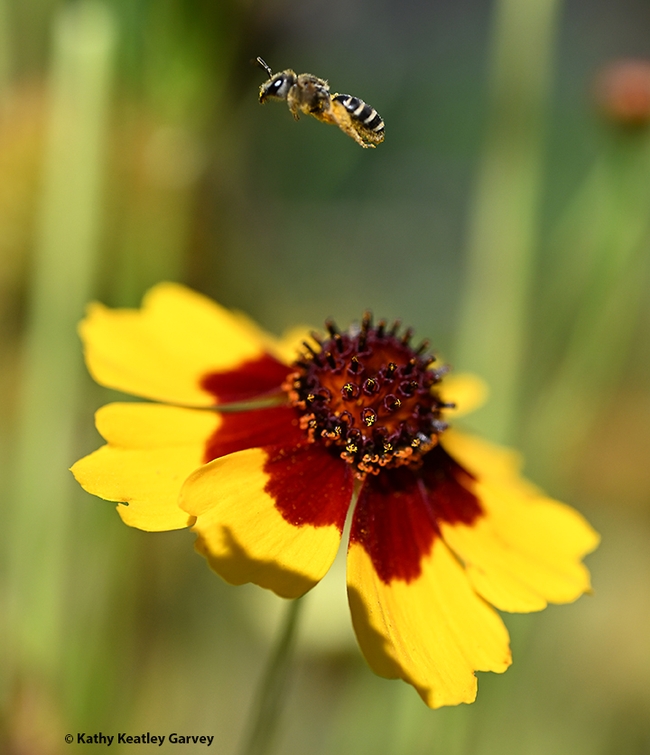
- Author: Kathy Keatley Garvey
Look closely at a patch of California golden poppies and you may see a sweat bee (genus Halictus) collecting gold pollen. The pollen basket is on the hind legs but you'll see "gold" also dusting the head and abdomen.
Native bee, commonly known as "halictid bee." Native plant. In fact, the California golden poppy, Eschscholzia californica, is the state flower.
And the rumor that it's "protected" and you'll get arrested if you pick a poppy along a roadside is inaccurate.
The California Department of Fish and Wildlife sets the record straight on its website: "It is often believed that there are laws prohibiting the cutting or damaging of the California poppy because it is the state flower. While there is no law protecting the California poppy specifically, California Penal Code Section 384a(opens in new tab) requires written landowner permission to remove and sell plant material from land that a person does not own, and removing or damaging plants from property that a person does not own without permission may constitute trespass and/or petty theft. However, these laws do not prevent the collection of California poppies on private land by the landowner. California poppies are a beautiful and easy-to-grow addition to your garden, and although you may choose to pick them from your property, they last much longer in the ground!"
Want to learn more about native bees? California has some 1600 species of wild or non-managed bees. Be sure to read California Bees & Blooms: A Guide for Gardeners and Naturalists. It's the work of University of California authors, all with UC Berkeley connections: Gordon Frankie, now professor emeritus, UC Berkeley; Robbin Thorp (1933-2019), UC Davis distinguished emeritus professor who received his doctorate in entomology from UC Berkeley; photographer Rollin Coville, who holds a doctorate in entomology from UC Berkeley, and Barbara Ertter, curator at the UC Berkeley-based University Herbarium and Jepson Herbarium.
The Bohart Museum of Entomology is hosting an open house on bees, both wild and managed, from 1 to 4 p.m., Sunday, May 19 in Room 1124, Academic Surge Building, 455 Crocker Lane. It's free and family free.
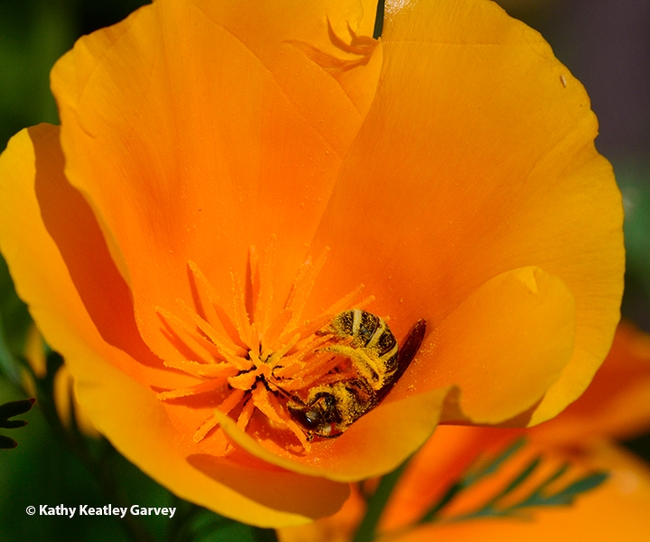
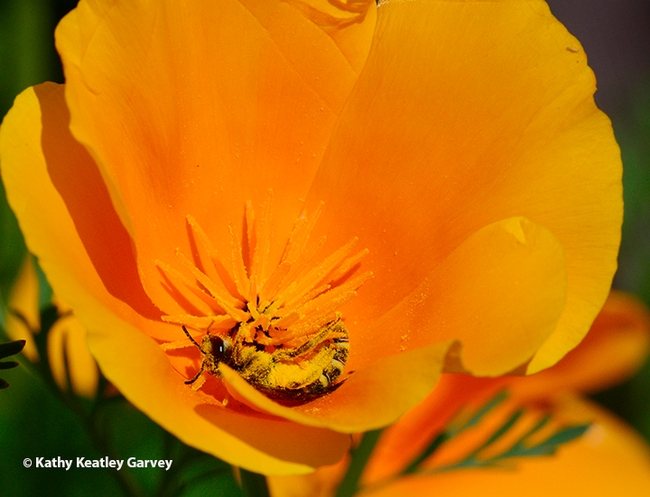
- Author: Kathy Keatley Garvey
"Sweat bees have earned their common name from the tendency, especially of the smaller species,to alight on one's skin and lap up perspiration for both its moisture and salt content."
So write University of California scientists in their award-winning book, California Bees and Blooms, a Guide for Gardeners and Naturalists.
California has some 1600 species of undomesticated or wild bees, point out the authors (Gordon Frankie, Robbin Thorp, Rollin Coville and Barbara Ertter).
And one of them is the sweat bee, Halictus ligatus, a member of the family Halictidae. It's a medium-sized, ground-nesting bee with a striped abdomen.
This week one of these species (as identified by research scientist John Ascher) looked especially striking on a Black-Eyed Susan, Rudbeckia hirta, a member of the Aster (Asteraceae) family. Both the plant and the bee are natives.
Several years ago we managed to photograph a flameskimmer dragonfly, Libellula saturata, munching on one of these sweat bees. Not a good day for that little gal!
No dragonflies were around, however, when we watched this one foraging on a Black-Eyed Susan.
Did you know that the Black-Eyed Susan is the designated state flower of Maryland? And that it was the inspiration for the University of Southern Mississippi's school colors (black and gold)? And that it's a larval host to butterflies such as the bordered batch, gorgone checkerspot and silvery checkerspot?
Who knew? If you plant it, though, be aware that it is toxic (when ingested) to cats.
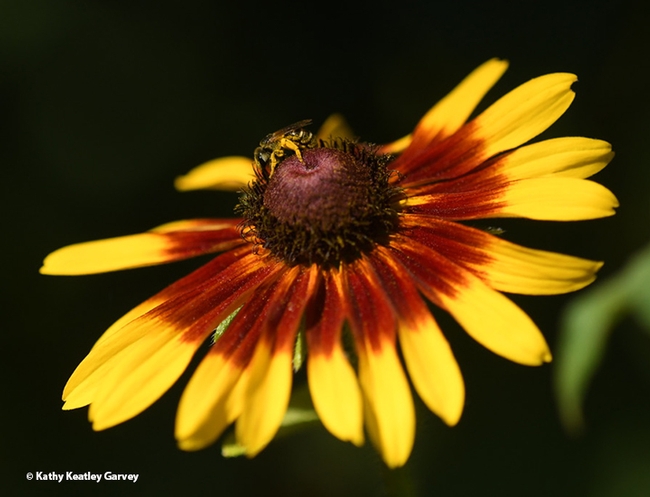
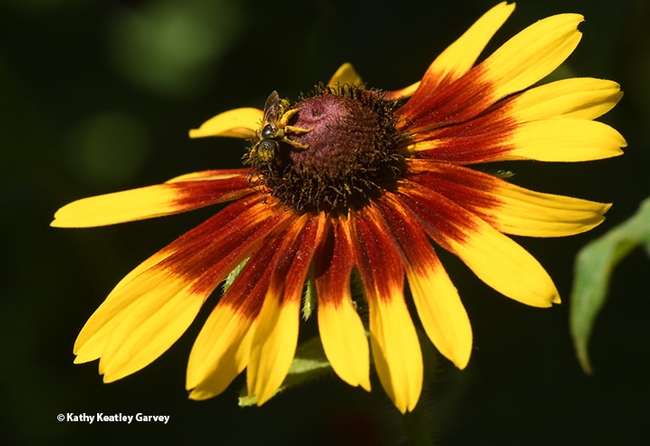
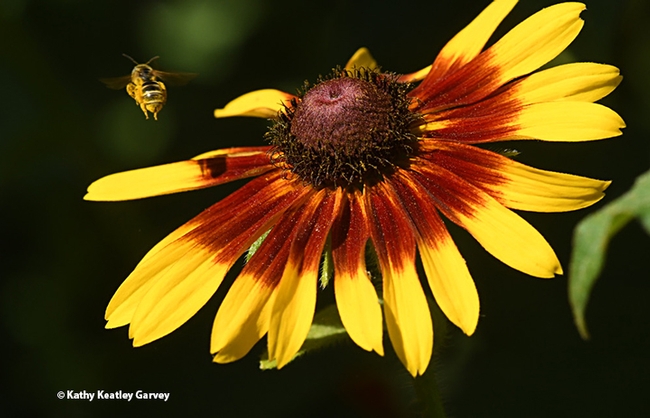
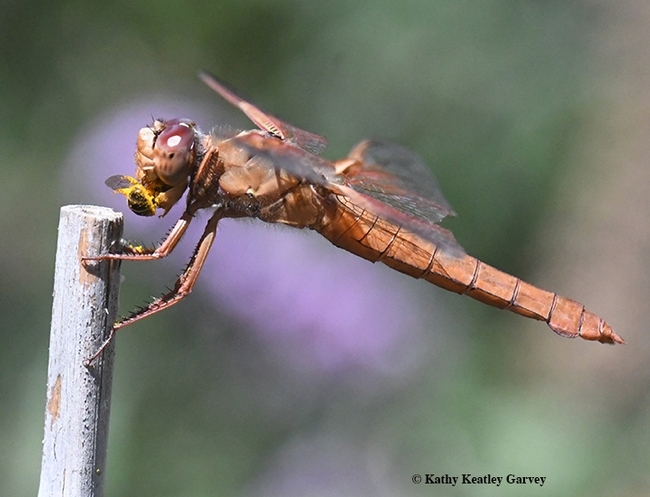
- Author: Kathy Keatley Garvey
Let's hear it for the sweat bee.
It's one of the many tiny bees that ought to be honored and recognized during Pollination Week, June 21-27, but it's often overlooked.
We've been seeing many of this species, Halictus tripartitus, in our pollinator garden in Vacaville. It's also called the "Tripartite Sweat Bee."
Thomas "Tom" Zavortink, a research entomologist and associate at the Bohart Museum of Entomology, UC Davis Department of Entomology and Nematology, noted why this one is Halictus tripartitus. "The abdominal terga appear to have apical hair bands, suggesting Halictus, and the scutum appears to have a slight metallic coloration, which along with the small size suggests Halictus tripartitus." Zavortink focuses on the systematics and biology associated with mosquitoes and solitary bees.
Check out BugGuide and Discover Life to see some excellent images of this species. The Great Sunflower Project also zeroes in on this species on this page.
Most Halictus are generalist foragers, according to the Great Sunflower Project. "They use all sorts of genera of plants from the Asteraceae to Scrophulariaceae. They are very common on composites (daisy-like disc and ray flowers) in summer and fall."
We've seen them on everything from mustard to milkweeds to catmint to rock purslane, from spring to fall. They also appear regularly on the tower of jewels (Echium wildpretii).
Let's hear it for the sweat bee, an overlooked and underloved little pollinator.
